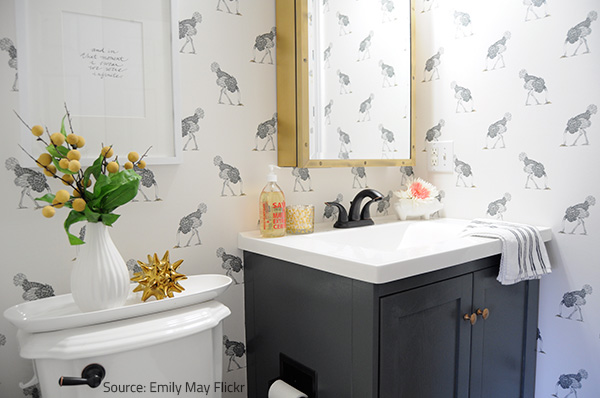How to Stop Bathroom Water Damage
How to Stop Bathroom Water Damage
Blog Article
Here in the next paragraph you might get more reliable material when it comes to How to Repair and Prevent Bathroom Water Damage?.

Water damage typically occurs in the shower room as a result of the water used daily. In some cases, the damages could be a little mold and mildew from the shower. Other times, it's large damages on your flooring. Whatever it is, it is constantly excellent to know the cause and avoid it prior to it occurs.
This guide will certainly go through a few of the common root causes of water damage in the restroom. We will additionally examine what you can do to avoid these reasons from damaging your washroom. Let's dive in.
5 Typical Causes of Water Damage in Shower Rooms
These are the usual reasons you would certainly have water damage in your bathrooms as well as just how you can spot them:
Ruptured or Dripping Pipes
There are numerous pipelines carrying water to different parts of your washroom. Some pipes take water to the toilet, the sink, the faucets, the shower, and also many other areas. They crisscross the small area of the shower room.
Once in a while, these pipes might obtain corroded and burst. Various other times, human activity could cause them to leak. When this occurs, you'll locate water in the corners of your bathroom or on the wall.
To identify this, keep an eye out for gurgling walls, molds, or mildew. Call an expert emergency situation plumbing professional to fix this when it happens.
Splits in your wall tilesv
Restroom wall surface floor tiles have actually been particularly designed for that purpose. They safeguard the wall from wetness from individuals taking showers. Nonetheless, they are not undestroyable.
Occasionally, your bathroom wall tiles crack and allow some moisture to leak into the wall. This might potentially ruin the wall if you don't take any type of action. If you notice a fracture on your wall tiles, fix it instantly. Don't wait up until it ruins your wall.
Overflowing toilets and sinks
As humans, sometimes we make blunders that can create some water damage in the washroom. As an example, leaving your sink faucet on might trigger overflowing and damage to other parts of the bathroom with dampness.
Likewise, a faulty toilet can create overruning. For instance, a damaged toilet handle or various other parts of the tank. When this occurs, it might damage the floor.
As quickly as you observe an overflowing sink or toilet, call a plumbing to help deal with it quickly.
Roofing Leaks
In some cases, the trouble of water damage to the washroom may not come from the washroom. As an example, a roofing leak can trigger damage to the bathroom ceiling. You can detect the damage done by looking at the water discolorations on the ceiling.
If you discover water stains on your ceiling, examine the roofing to see if it's damaged. After that, call an expert to aid fix the issue.
Excess Dampness
It's great to have that long shower and also splash water while you hem and haw as well as act like you're executing, yet in some cases these acts can trigger water damage to your shower room.
Spraying water around can trigger water to go to edges and create molds. See exactly how you spread out excess wetness around, and when you do it, clean it up to avoid damage.
Final thought
Water damage to your bathroom can be aggravating. Nevertheless, you can manage it if you avoid several of the causes pointed out in this guide. Call a specialist emergency plumbing professional if you discover any kind of severe damage.
How to Prevent Water Damage in Your Bathroom?
Water damage repair is an expensive, meticulous, and lengthy process. Unfortunately, bathrooms are the most susceptible rooms to water damage due to toilets, showers, and sinks. Pipes and fixtures wear out over time and are not immune to damage. But all is not lost, as there are ways to prevent water damage from occurring in your bathroom.
Check Your Plumbing
Nothing lasts forever, especially pipes, which can rust and begin leaking over time. You should periodically conduct pipe inspections and pay attention for any musty smells or water stains that may indicate you need water damage repair. Here are some things to check:
Frequently test valves for your toilet, shower, and sink to ensure they are properly working.
Check faucet supply lines hidden under vanities and replace when needed.
Replace cracked or deteriorating caulking along sinks, tubs, and showers.
If you notice a clog in your sink, call in a professional.
Since you can’t check the pipes in the wall, keep an eye out for stains, drywall bubbling, musty smells, and excess moisture; if the bathroom is on a second level, check the ceiling of the room directly below for these signs.
Don’t Overwork Your Toilet
One of the most common reasons bathrooms need water damage repair is due to overflowing toilets. Save yourself the hassle of cleanup by being mindful and not pushing your toilet to extreme limits. If you have young children, it is especially important to keep an eye on them when they are in the bathroom and to teach them how to avoid clogging the toilet. Here are some more tips to help prevent your toilet from overflowing:
If you have a septic tank, only use septic-safe toilet paper
Do not flush anything down the toilet besides toilet paper; items like diapers and sanitary napkins will clog the piping
Pay attention to your toilet’s water level: If it’s low, it could mean it is partially clogged or that there is a crack in the toilet bowl
https://www.alure.com/home-improvements-blog/resources/how-to-prevent-water-damage-in-your-bathroom

How to Prevent Water Damage in Your Bathroom?
Water damage repair is an expensive, meticulous, and lengthy process. Unfortunately, bathrooms are the most susceptible rooms to water damage due to toilets, showers, and sinks. Pipes and fixtures wear out over time and are not immune to damage. But all is not lost, as there are ways to prevent water damage from occurring in your bathroom.
Check Your Plumbing
Nothing lasts forever, especially pipes, which can rust and begin leaking over time. You should periodically conduct pipe inspections and pay attention for any musty smells or water stains that may indicate you need water damage repair. Here are some things to check:
Don’t Overwork Your Toilet
One of the most common reasons bathrooms need water damage repair is due to overflowing toilets. Save yourself the hassle of cleanup by being mindful and not pushing your toilet to extreme limits. If you have young children, it is especially important to keep an eye on them when they are in the bathroom and to teach them how to avoid clogging the toilet. Here are some more tips to help prevent your toilet from overflowing:
https://www.alure.com/home-improvements-blog/resources/how-to-prevent-water-damage-in-your-bathroom
I ran across that content about How to Repair and Prevent Bathroom Water Damage? while doing a lookup on the web. Sharing is good. Who knows, you may be helping someone out. Thank you for taking the time to read it.
Visit Our Website Report this page